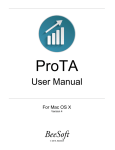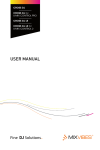Download Wiley Microsoft Dynamics GP For Dummies
Transcript
Chapter 1 RI AL What Microsoft Dynamics GP Does Best TE In This Chapter Familiarizing yourself with the Microsoft Dynamics GP window MA Understanding Dynamics GP terms Knowing how Dynamics GP keeps your CPA happy D M GH TE icrosoft Dynamics GP is a robust accounting package that can meet the needs of any number of types of organizations. All installations of Dynamics GP have certain characteristics in common. In this chapter, I describe these common characteristics and, in the process, introduce you to Dynamics GP lingo. PY RI Introducing Microsoft Dynamics GP CO Familiarizing yourself with the Microsoft Dynamics GP window is the first order of business. You’ll find it much easier to perform tasks if you know how to find them. In Figure 1-1, you see a typical Dynamics GP opening window. Dynamics GP uses a Navigation pane down the left side of the window, similar to the one found in Microsoft Outlook. The Navigation pane enables you to, well, navigate to various places in the program. In Figure 1-1, I clicked Home in the Navigation pane. The Home page you see in the Content pane when you open Dynamics GP on your computer might not match the one shown in Figure 1-1 because you can customize the Home page — and you can read about customizing your Dynamics GP Home page in the section “At Home with the Home Page,” later in this chapter. 8 Part I: Great Things with Microsoft Dynamics GP Toolbar buttons Navigation pane Menu bar Content pane Address bar Figure 1-1: A typical opening window in Dynamics GP. The current user Navigation pane buttons The current company User date Along the top of the screen, you can use the Address bar to type locations within Dynamics GP and then press Enter or click the Refresh button at the right end of the Address bar to view those locations. But most people use the Menu bar, which appears just below the Address bar, and the Navigation pane to move around Dynamics GP. Menus and toolbars The Menu bar is actually one of several toolbars available in Dynamics GP. Its official name is the Main toolbar but it functions just like the menu bars in other programs you’ve used, so I’m going to call it the Menu bar. Below the Menu bar (refer to Figure 1-1) you see the Standard toolbar. If you’re a “button” person, you can display any of the available toolbars by rightclicking the toolbar area to display the shortcut menu shown in Figure 1-2. From this shortcut menu, click any toolbar you want to display. If a check Chapter 1: What Microsoft Dynamics GP Does Best mark appears beside the toolbar name it’s already displayed, and clicking it removes the check mark and hides that particular toolbar. Figure 1-2: Right-click the toolbar area to display this shortcut menu and control the visible toolbars. The Navigation and Content panes Let’s take a moment to focus on the main portion of the window, which is divided into two parts. The Navigation pane runs down the left side of the window, and the results of clicking something in the Navigation pane appear in the Content pane on the right side of the window. In Figure 1-3, I clicked the Sales series button in the Navigation pane. Navigation pane buttons The buttons along the bottom portion of the Navigation pane represent series of related functions in Dynamics GP. When you click any particular Navigation pane button, lists associated with that series appear above the buttons in the Navigation pane, and the actions you can take within the series fill the Content pane on the right side of the Dynamics GP window (refer to Figure 1-3). I’ll tell you more about lists in the next section, but for the time being let’s focus on the buttons in the Navigation pane. 9 10 Part I: Great Things with Microsoft Dynamics GP Lists for the selected series Content pane containing actions for the selected series Figure 1-3: The Navigation pane. Toolbar-like buttons for additional series Navigation pane buttons Looking back at Figure 1-3, you see “named” buttons for Home, Financial, Sales, Purchasing, and Inventory. In addition to these named buttons, toolbar-like buttons appear at the bottom of the Navigation pane (in Figure 1-3 they appear under the named Inventory button). These toolbar-like buttons function the same way that the named buttons function — they simply represent additional series of related functions such as Human Resources and Payroll. If you place the mouse pointer over one of the toobar-like buttons, a tool tip appears to identify the button. You can increase or decrease the number of named buttons that appear in the Navigation pane. Click the Configure Buttons button, which is the last button in the area where the toolbar-like buttons appear. When you click the Configure Buttons button a shortcut menu appears, as shown in Figure 1-4. To display more buttons with names, click Show More Buttons. To display more toolbar-like buttons, click Show Fewer Buttons. When you show more buttons, Dynamics GP moves a toolbar-like button up and displays it as a named button. Similarly, if you show fewer buttons, Dynamics GP removes a named button but displays a toolbar-like button for it. Chapter 1: What Microsoft Dynamics GP Does Best Figure 1-4: Add or remove named buttons in the Navigation pane. The Configure Buttons button In addition to controlling how many named buttons appear, you can control the order in which the buttons appear. You also can prevent buttons from appearing for business functions your company doesn’t use. For example, if you outsource your payroll functions, you can prevent the HR & Payroll button from appearing. To control the buttons that appear in the Navigation pane, right-click any button in the Navigation pane and then click Navigation Pane Options. The Navigation Pane Options dialog box appears (see Figure 1-5). Remove check marks beside any button you do not want to display in the Navigation pane by clicking the check box. To change the order of the Navigation pane buttons, select a button in the list by clicking on it and then clicking the Move Up or Move Down buttons. Click OK when you finish, or click Reset to return to the defaults. Lists The Navigation pane also contains lists for the selected series. Using a list you can view similar records, select one or more records, and then simultaneously perform actions for all of the selected records. For example, in the Customers list shown in Figure 1-6, you can select multiple customer records and then print statements for the selected customers. 11 12 Part I: Great Things with Microsoft Dynamics GP Figure 1-5: Use this dialog box to specify the buttons to display in the Navigation pane and the order in which they should appear. Filter area Action pane Figure 1-6: Lists help you perform actions simultaneously in Dynamics GP. Information pane List area Chapter 1: What Microsoft Dynamics GP Does Best You select the action you want to take in the Action pane of the List window. You can add filters in the Filter area. The list elements (in this example, the list elements are the customers) appear in the List area, and you select various list elements with check marks to take actions on them. The details for any list element you highlight — regardless of whether you place a check mark by the list element — appears at the bottom of the List window in the Information pane. If you have proper security privileges, you can create list views that contain just the information you want to view. See Chapter 15 for details. Who, when, and where you are At the very bottom of the Dynamics GP window, the user date (usually the current day’s date; Dynamics GP uses the date set on your computer) appears in the lower-left corner. Beside it, you see the name of the company in which you are working, and beside the company name you see the name of the user who is currently logged into the company (refer to Figure 1-1). If you move your mouse pointer over any of these three pieces of information, you’ll find that they are buttons. If you click any of these buttons, you can make changes. For example, you can change the user date by clicking the Date button. Or, you can switch companies by clicking the name of the current company; when you do, the Company Login window appears (see Figure 1-7). Select the company you want to open from the drop-down list and click OK. The user date acts as the default date for transactions or batches you post, and depending on your report options it might be used to filter reports. The system date is merely a handy default, and you can override it when you add, edit, or post transactions. Figure 1-7: Use this dialog box to log in to a Dynamics GP company. 13 14 Part I: Great Things with Microsoft Dynamics GP When you click the name of the currently logged in user, a dialog box very similar to the one shown in Figure 1-7 appears. You can select a server on which Dynamics GP is installed and type a User ID and password, but you have no option to select a company. At Home with the Home Page You can customize your Home page so that it helps you work efficiently. You can add information, reorganize the information, change the information that appears in each pane, and customize the To Do and Quick Links areas. Let’s take a look at the process. Adding to and reorganizing the Home page In Figure 1-8, you see a typical Home page. In the Content pane, you see areas for To Do and My Reports on the left, and the Quick Links and Microsoft Office Outlook areas on the right. You can move these areas around and you can change the information that appears in some of these areas. You also can add a Metrics area that displays graphics for information that is important to you. Let’s add the Metrics area to the left side of the Content pane, below the My Reports area. Follow these steps: 1. Click the Customize This Page link in the upper-right corner of the Home page’s Content pane (refer to Figure 1-8). The Customize Home Page dialog box appears (see Figure 1-9). 2. To add the Metrics area to the Home page, select the Metrics check box. 3. To make the Metrics area appear on the left side of the Content pane, click Metrics in the Column 2 list and then click the arrow pointing left towards Column 1. You can reorder the areas in the Content pane using the Move Up and Move Down buttons on either side of the Column 1 and Column 2 lists. 4. Click OK. Your newly modified Home page appears (see Figure 1-10). Chapter 1: What Microsoft Dynamics GP Does Best The Customize This Page link Figure 1-8: The different areas of the Content pane of a typical Home page. Figure 1-9: Use this dialog box to customize your Home page. 15 16 Part I: Great Things with Microsoft Dynamics GP Figure 1-10: The Home page after adding the Metrics area. Notice the left- and right-pointing arrows in the upper-left corner of the Metrics area of Figure 1-10? Click these buttons to display other metric charts you’ve selected to view. Read the next section for more on how to select metric charts to view. Changing the details of a Home page You can change the details that appear in any area on the Home page. For example, you can specify the metric charts you want available in the Metrics area. Move the mouse pointer into any area (I moved into the Metrics area in Figure 1-10) and buttons appear at the right edge of the area’s title bar. By clicking the pencil button, you can display the details available for the area and select the ones you want to display. In Figure 1-11, you see the Metrics Details dialog box. The appearance of a “details” dialog box changes, depending on the one you choose to view. Suppose that you want to add the Total Purchases for the Past 12 Months chart to the Metrics you can view from your Home page. Follow these steps: Chapter 1: What Microsoft Dynamics GP Does Best 1. In the Metrics Details dialog box, click the chart you want to add. In this case, Total Purchases for the Past 12 Months. 2. Click the Insert button. To change the order of the charts you display on your Home page, use the Move Up and Move Down buttons. 3. Click OK when you finish. Figure 1-11: The Metrics Details dialog box, where you select the Metrics charts you want available on your Home page. Customizing the Quick Links area You might want to set up Quick Links to reports, macros, and data entry screens you use regularly. You follow the same basic steps as you did in the previous section for the Metrics area, but you have a few more options you can set. For example, you can add a link to a Dynamics GP window, a Dynamics GP navigation list, a Web page, or an external file or program, as shown in Figure 1-12. You also can provide your own name for a Quick Link entry. For example, you’ll find a Transaction Entry window in the Purchasing series and in the Sales series. If you add both to your Quick Link list, you’ll want a way to distinguish them. In the Quick Links Details dialog box, click the entry you want to rename and then click the Modify button. The Properties box for the entry you selected appears (see Figure 1-13). In the Name box, type the name you want Dynamics GP to display in the Quick Links list and then click OK. 17 18 Part I: Great Things with Microsoft Dynamics GP Figure 1-12: The types of links you can add to the Quick Links list. Figure 1-13: In the Name box, type the name you want displayed in the Quick Links list. Customizing the To Do area You can display reminders, tasks, and, if you’re using the Workflow module, workflow tasks and notifications in the To Do area of the Home page. You can let Dynamics GP create reminders for you for a variety of conditions. For example, you can have Dynamics GP remind you to post various recurring batches. Tasks may be (but are not necessarily) tied to some Dynamics GP event or window, and you can create recurring and non-recurring tasks that you can assign to yourself or someone else. For example, you can create a task to remind yourself to print monthly reports or send out customer satisfaction letters. If you don’t display reminders in the To Do area of your Home page, reminders, along with tasks that are due today or are overdue, appear in the Reminders window. The Reminders window appears automatically when you start Dynamics GP, or you can open the Reminders window by choosing Microsoft Dynamics GP➪Reminders from the Menu bar. You also can open the Task List window by choosing Microsoft Dynamics GP➪Task List in the Menu bar. Chapter 1: What Microsoft Dynamics GP Does Best Familiarity Breeds Affection, Efficiency, and Productivity . . . and a Pay Raise Dynamics GP contains certain common features that you use as you work in the product. If you click a series button in the Navigation pane, you’ll see that the Content pane for each series is organized in the same manner, with headings for Cards, Transactions, Inquiry, Reports, Routines, Utilities, and Setup. In the sections that follow, I describe these common functions, along with some other common features available throughout all series in Dynamics GP. Cards When you store background information in Dynamics GP, you use a card. What do I mean by background information? Well, for example, you need to store names and addresses and other vital information about your customers and your vendors. For your chart of accounts, you need to store an account name, type, and number. You store this information on cards. Then, when you create a customer invoice or a vendor bill, Dynamics GP uses the card information to fill in this pertinent information on the invoice or bill — saving you the time you’d spend looking up and then filling in the information repeatedly. In Figure 1-14, you see a sample Customer card. Figure 1-14: A typical Customer card. 19 20 Part I: Great Things with Microsoft Dynamics GP But you can set up more than just name and address information for customers and vendors; you can set up cards for other types of related information. For example, in addition to Customer cards, you can set up cards that associate a customer with the vendor you typically order from for the customer. You also can set up a card that identifies items typically ordered by a customer, and you can set up a card for each salesperson that stores his or her commission rate, address, sales territory, and sales manager, so that all sales commissions on invoices are applied to the correct salesperson and sales manager. In Part II, I discuss more details about cards for customers, vendors, inventory items, and the General Ledger. Cards for a particular series appear in the rightside of the Dynamics GP window when you select that series in the Navigation pane. Or, you can find all of the cards that you can create by clicking Cards on the Menu bar and then pointing to the appropriate series within Dynamics GP. Transactions Transactions are the entries you make to record accounting events in Dynamics GP. You can enter transactions individually or in batches, and you use different windows within a series to enter individual transactions or transactions in batches. For example, you when you receive a bill from a vendor, you can use the Payables Transaction Entry window, shown in Figure 1-15, to record the individual bill and track it for payment. Figure 1-15: Use this window to enter an individual vendor bill. To create a batch of vendor bills, you use the Payables Batch Entry window, shown in Figure 1-16. You can create single-use batches, where you simply enter a series of transactions into a batch, or you can create recurring batches, which are particularly useful if you enter the same transactions on some regular Chapter 1: What Microsoft Dynamics GP Does Best basis. For example, if you pay certain bills weekly, you can create a batch that contains all of those weekly bills and avoid entering those bills every week. The recurring batch feature is especially useful to record monthly journal entries in the General Ledger. Those recurring batches can act as a checklist of closing entries. Figure 1-16: Use this window to record a batch of vendor bills. Using batches is a handy way to separate work into different posting periods when you set up transactions to post by batch date. And, using the Control Totals feature of batches, you can ensure that you record all of the transactions because you provide a total number of transactions and the associated dollar amount when you set up the batch. Microsoft Dynamics GP monitors the number of transactions you subsequently record in the batch and the total dollars of each transaction; the batch totals should match the number and dollar amount total of the individual transactions in the batch. Microsoft Dynamics GP posts transactions to update your company files. In Chapter 2, you read about the posting options that you can set; suffice it to say at this point that, in most cases, when you post a transaction you post it throughout the Dynamics GP system so that the transaction updates all appropriate journals and ledgers. The way you enter transactions controls the timing associated with posting. If you enter transactions individually, you can set up your company so that Dynamics GP posts the transaction immediately, and your records are always up to date. If you enter transactions in batches, you also post them in batches. Saving a batch of transactions doesn’t post the batch; you take a 21 22 Part I: Great Things with Microsoft Dynamics GP separate action to actually post the transactions. In general, you can edit or delete transactions in unposted batches as needed. To make a change to a posted transaction, you need to enter another transaction that corrects the effects of the original transaction. That way, Audit Trails shows the history of each transaction and ties transactions together appropriately. You can read more about Audit Trails later in this chapter in the section “Keeping Your CPA Happy,” and in Chapter 2. Transactions available for a particular series appear in the Content pane of the Dynamics GP window when you select that series in the Navigation pane. Or, you can find all of the transactions that you can create by clicking Transactions in the Menu bar and then pointing to the appropriate series within Dynamics GP. Inquiries You can use inquiries in Dynamics GP to review information in a quick and efficient manner. You can view summary or detailed information and, in many cases, sort the information. For example, suppose that you’d like a quick picture that summarizes your company’s outstanding receivables. On the Menu bar, you can click Inquiry➪Sales➪Receivables Summary to display the window shown in Figure 1-17. Then, to view your receivables picture company-wide, click the Calculate button. Figure 1-17: Use an inquiry to quickly determine your company’s current receivables picture. Chapter 1: What Microsoft Dynamics GP Does Best You also can use this window to see the receivables status for a single customer. Reports You’ll find a plethora of reports available for each series in Dynamics GP — reports that enable you to both verify and analyze company information. To view the available reports, click Reports on the Menu bar. The categories of reports appear; as you highlight a category, the reports in that category appear. See Chapter 12 for details on setting report options and printing reports. Routines Routines are tasks you perform on a periodic basis. For example, you can use routines to run monthly customer statements or apply finance charges to customers. To see the routines available in Dynamics GP, click Microsoft Dynamics GP on the Menu bar, and then choose Tools➪Routines. Utilities Utilities help you clean up data by removing it. You also can use utilities to check and repair your data if discrepancies appear. For example, a power outage while you’re using Dynamics GP can result in transactions being partially but not completely posted. You can use utilities to track down the problems. Also, some utilities save you time by allowing you to make mass changes to your data. For example, the Price List utility is a wizard that lets you copy price lists from one item to another item or a range of items. In Chapter 13, you find more information on using utilities to find and repair problems. You can view the available utilities by going to the Menu bar and choosing Microsoft Dynamics GP➪Tools➪Utilities. Setup If you have sufficient security rights (see Chapter 14), such as the rights of a power user, and you click any series in the Navigation pane, you’ll see a section in the Content pane called Setup. In that section, you’ll see a list of links you can click to set up the behavior of Dynamics GP. For example, in Figure 1-18, you see the links available in the Setup area for the Sales series. 23 24 Part I: Great Things with Microsoft Dynamics GP Figure 1-18: Each series displays an area in the Content pane where you can set up various aspects of the series. If you click each of these links, you can establish the way you want Dynamics GP to behave using the options that appear. In Figure 1-19, you see the Receivables Management Setup window, which displays the options available when you click the Receivables link in the Setup area of the Content pane. Figure 1-19: Using Setup windows, you can determine Dynamics GP’s behavior in various situations. Chapter 1: What Microsoft Dynamics GP Does Best Yellow sticky notes In every window in Dynamics GP, next to almost every field you’ll see an icon that looks like a piece of paper — and functions like a sticky note (see Figure 1-20). The Note icon Figure 1-20: You can attach notes to fields in a window. When you click any particular Note icon, a window like the one in Figure 1-21 appears; you can use this window to store free-form information. Figure 1-21: Use Note windows to store freeform text. 25 26 Part I: Great Things with Microsoft Dynamics GP Working with SmartLists SmartLists provide you with fast, easy access to information in your Dynamics GP company. Using a SmartList query, you can quickly and easily obtain information about accounts, customers, employees, vendors, transactions, and items. You can display the results on-screen, print the information, or send it to Word or Excel. For example, suppose that you want to view all of your 1099 vendors. You can use a SmartList like the one shown in Figure 1-22 to display a list of all of your 1099 vendors. You also can export SmartList information to an Excel or Word file. Figure 1-22: Quickly and easily display information stored in your Dynamics GP company. SmartLists can also be used to facilitate workflow. If you assign users to monitor particular lists, you can create queues of work to be performed. Because all users, including managers, can view the SmartLists, a bottleneck in the workflow becomes immediately apparent. SmartLists also can replace paper-based workflows that typically sit in a basket on someone’s desk. For example, you can create a SmartList for Sales Orders in a certain batch named “URGENT” and then assign the shipping department to monitor this SmartList and ship those orders ahead of others. To view the SmartList window, click Microsoft Dynamics GP➪SmartList in the Menu bar. For more information on using SmartLists, see Chapter 12. Chapter 1: What Microsoft Dynamics GP Does Best Reminders and tasks Dynamics GP can create reminders for you for a variety of conditions. For example, you can have Dynamics GP remind you about overdue invoices a specified number of days past the due date. Or, you might want to create a reminder to post various recurring batches. You also can create custom reminders — reminders that you define. The Reminders window, shown in Figure 1-23, appears automatically when you start Dynamics GP if you have reminders or tasks that are due today or overdue. Or, you can open the window by choosing Microsoft Dynamics GP➪Reminders. Figure 1-23: The Reminders window. The Reminders window doesn’t appear if you choose to display reminders in the To Do area of your Home page. See Chapter 2 for details on customizing your Home page. You can create tasks that you assign to yourself or someone else using Dynamics GP. Tasks appear in the Reminders window (refer to Figure 1-23) and in the Task List window, which you can open by choosing Dynamics GP➪Task List. Using either window, you can monitor or set the progress of a task. See Chapter 15 for details on creating reminders and tasks. 27 28 Part I: Great Things with Microsoft Dynamics GP Keeping Your CPA Happy Dynamics GP contains a feature called Audit Trails that makes accountants very happy. Using the Audit Trails feature, you can trace a transaction from anywhere in your Dynamics GP company back to the location where you originally entered it. Read more about setting up the Audit Trails feature in Chapter 2. You also can purchase the Audit Trails module, which enables you to monitor each user’s activity in Dynamics GP. Using the Audit Trails module, you can view before and after snapshots of records that have changed. You can decide exactly what changes you want to track; for example, you can capture a change made to an inventory item description. The Audit Trails module notes the change, the date and time of the change, and the user who made the change.





























